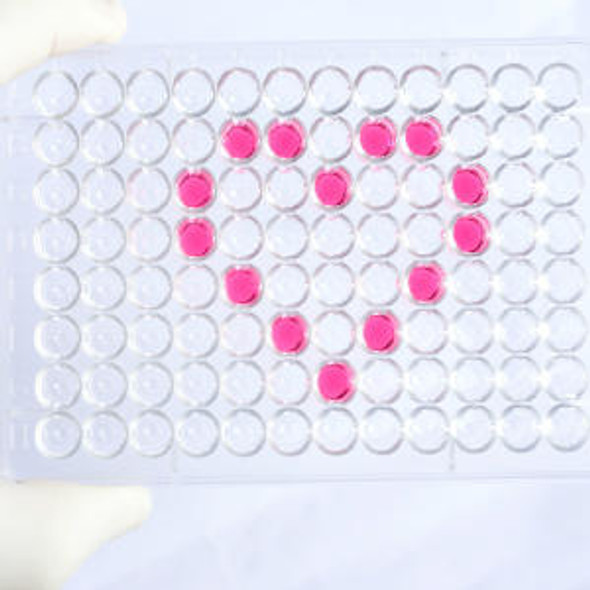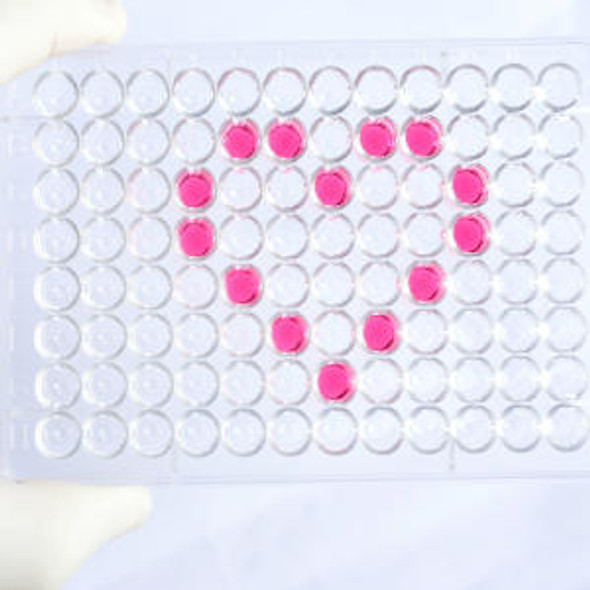Human GDF7 (Growth Differentiation Factor 7) ELISA Kit (HUES02859)
- SKU:
- HUES02859
- Product Type:
- ELISA Kit
- Size:
- 96 Assays
- Uniprot:
- Q7Z4P5
- Sensitivity:
- 37.5pg/mL
- Range:
- 62.5-4000pg/mL
- ELISA Type:
- Sandwich
- Synonyms:
- BMP12
- Reactivity:
- Human
- Sample Type:
- Serum, plasma and other biological fluids
Description
Human GDF7 (Growth Differentiation Factor 7) ELISA Kit
The Human GDF7 (Growth Differentiation Factor 7) ELISA Kit is designed for the precise and accurate detection of GDF7 levels in human serum, plasma, and cell culture supernatants. This kit offers exceptional sensitivity and specificity, ensuring dependable and reproducible results that are suitable for a variety of research applications.GDF7 is a vital protein that plays a crucial role in growth and differentiation processes, influencing cellular development and tissue regeneration. It is involved in various biological functions, including skeletal development, muscle regeneration, and joint formation.
The detection and quantification of GDF7 levels can provide valuable insights into developmental disorders, musculoskeletal diseases, and potential therapeutic interventions.This ELISA kit provides researchers with a powerful tool for studying the role of GDF7 in various physiological and pathological processes, offering a comprehensive and reliable solution for investigating the molecular mechanisms underlying these conditions.
| Assay type: | Sandwich |
| Format: | 96T |
| Assay time: | 4.5h |
| Reactivity: | Human |
| Detection Method: | Colormetric |
| Detection Range: | 62.50-4000 pg/mL |
| Sensitivity: | 37.50 pg/mL |
| Sample Volume Required Per Well: | 100µL |
| Sample Type: | Serum, plasma and other biological fluids |
| Specificity: | This kit recognizes Human GDF7 in samples. No significant cross-reactivity or interference between Human GDF7 and analogues was observed. |
This ELISA kit uses Sandwich-ELISA as the method. The micro ELISA plate provided in this kit has been pre-coated with an antibody specific to Human GDF7. Standards or samples are added to the appropriate micro ELISA plate wells and combined with the specific antibody. Then a biotinylated detection antibody specific for Human GDF7 and Avidin-Horseradish Peroxidase (HRP) conjugate are added to each micro plate well successively and incubated. Free components are washed away. The substrate solution is added to each well. Only those wells that contain Human GDF7, biotinylated detection antibody and Avidin-HRP conjugate will appear blue in color. The enzyme-substrate reaction is terminated by adding Stop Solution and the color turns yellow. The optical density (OD) is measured spectrophotometrically at a wavelength of 450 nm ± 2 nm. The OD value is proportional to the concentration of Human GDF7. The concentration of Human GDF7 in samples can be calculated by comparing the OD of the samples to the standard curve.
| UniProt Protein Function: | GDF7: May play an active role in the motor area of the primate neocortex. Belongs to the TGF-beta family. |
| UniProt Protein Details: | Protein type:Cytokine; Secreted; Secreted, signal peptide; Cell development/differentiation Chromosomal Location of Human Ortholog: 2p24. 1 Cellular Component: extracellular space Molecular Function:cytokine activity; growth factor activity; protein binding; protein homodimerization activity; transforming growth factor beta receptor binding Biological Process: activin receptor signaling pathway; axon guidance; BMP signaling pathway; branching morphogenesis of a tube; cell development; cell fate commitment; epithelial cell differentiation; forebrain morphogenesis; gland morphogenesis; growth; midbrain development; positive regulation of neuron differentiation; positive regulation of transcription, DNA-dependent; regulation of apoptosis; regulation of MAPKKK cascade; reproductive structure development; roof plate formation; spinal cord association neuron differentiation |
| NCBI Summary: | This gene encodes a member of the bone morphogenetic protein (BMP) family. BMPs belong to the transforming growth factor-beta superfamily of secreted signalling molecules that regulate diverse processes in growth, repair and embryonic development. In mouse, this gene functions as an inductive signal from the roof plate required for the specification of neuronal identity in the dorsal spinal cord. [provided by RefSeq, Jul 2008] |
| UniProt Code: | Q7Z4P5 |
| NCBI GenInfo Identifier: | 296434517 |
| NCBI Gene ID: | 151449 |
| NCBI Accession: | Q7Z4P5. 2 |
| UniProt Related Accession: | Q7Z4P5 |
| Molecular Weight: | 46,950 Da |
| NCBI Full Name: | Growth/differentiation factor 7 |
| NCBI Synonym Full Names: | growth differentiation factor 7 |
| NCBI Official Symbol: | GDF7 |
| NCBI Official Synonym Symbols: | BMP12 |
| NCBI Protein Information: | growth/differentiation factor 7 |
| UniProt Protein Name: | Growth/differentiation factor 7 |
| Protein Family: | Growth/differentiation factor |
| UniProt Gene Name: | GDF7 |
| UniProt Entry Name: | GDF7_HUMAN |
As the OD values of the standard curve may vary according to the conditions of the actual assay performance (e. g. operator, pipetting technique, washing technique or temperature effects), the operator should establish a standard curve for each test. Typical standard curve and data is provided below for reference only.
| Concentration (pg/mL) | O.D | Average | Corrected |
| 4000 | 2.479 2.483 | 2.481 | 2.4 |
| 2000 | 1.565 1.605 | 1.585 | 1.504 |
| 1000 | 0.971 0.957 | 0.964 | 0.883 |
| 500 | 0.427 0.429 | 0.428 | 0.347 |
| 250 | 0.27 0.27 | 0.27 | 0.189 |
| 125 | 0.181 0.175 | 0.178 | 0.097 |
| 62.50 | 0.122 0.14 | 0.131 | 0.05 |
| 0 | 0.077 0.085 | 0.081 | -- |
Precision
Intra-assay Precision (Precision within an assay): 3 samples with low, mid range and high level Human GDF7 were tested 20 times on one plate, respectively.
Inter-assay Precision (Precision between assays): 3 samples with low, mid range and high level Human GDF7 were tested on 3 different plates, 20 replicates in each plate.
| Intra-assay Precision | Inter-assay Precision | |||||
| Sample | 1 | 2 | 3 | 1 | 2 | 3 |
| n | 20 | 20 | 20 | 20 | 20 | 20 |
| Mean (pg/mL) | 210.65 | 468.00 | 1473.31 | 197.71 | 425.54 | 1348.21 |
| Standard deviation | 10.89 | 25.23 | 45.82 | 10.72 | 17.66 | 42.06 |
| C V (%) | 5.17 | 5.39 | 3.11 | 5.42 | 4.15 | 3.12 |
Recovery
The recovery of Human GDF7 spiked at three different levels in samples throughout the range of the assay was evaluated in various matrices.
| Sample Type | Range (%) | Average Recovery (%) |
| Serum (n=5) | 96-110 | 102 |
| EDTA plasma (n=5) | 84-98 | 90 |
| Cell culture media (n=5) | 89-106 | 97 |
Linearity
Samples were spiked with high concentrations of Human GDF7 and diluted with Reference Standard & Sample Diluent to produce samples with values within the range of the assay.
| Serum (n=5) | EDTA plasma (n=5) | Cell culture media (n=5) | ||
| 1:2 | Range (%) | 89-103 | 87-101 | 88-105 |
| Average (%) | 96 | 93 | 96 | |
| 1:4 | Range (%) | 90-105 | 88-99 | 85-96 |
| Average (%) | 98 | 93 | 90 | |
| 1:8 | Range (%) | 86-101 | 80-92 | 88-101 |
| Average (%) | 93 | 86 | 93 | |
| 1:16 | Range (%) | 92-107 | 87-100 | 89-99 |
| Average (%) | 99 | 92 | 94 |
An unopened kit can be stored at 4°C for 1 month. If the kit is not used within 1 month, store the items separately according to the following conditions once the kit is received.
| Item | Specifications | Storage |
| Micro ELISA Plate(Dismountable) | 8 wells ×12 strips | -20°C, 6 months |
| Reference Standard | 2 vials | |
| Concentrated Biotinylated Detection Ab (100×) | 1 vial, 120 µL | |
| Concentrated HRP Conjugate (100×) | 1 vial, 120 µL | -20°C(shading light), 6 months |
| Reference Standard & Sample Diluent | 1 vial, 20 mL | 4°C, 6 months |
| Biotinylated Detection Ab Diluent | 1 vial, 14 mL | |
| HRP Conjugate Diluent | 1 vial, 14 mL | |
| Concentrated Wash Buffer (25×) | 1 vial, 30 mL | |
| Substrate Reagent | 1 vial, 10 mL | 4°C(shading light) |
| Stop Solution | 1 vial, 10 mL | 4°C |
| Plate Sealer | 5 pieces | |
| Product Description | 1 copy | |
| Certificate of Analysis | 1 copy |
- Set standard, test sample and control (zero) wells on the pre-coated plate and record theirpositions. It is recommended to measure each standard and sample in duplicate. Note: addall solutions to the bottom of the plate wells while avoiding contact with the well walls. Ensuresolutions do not foam when adding to the wells.
- Aliquot 100µl of standard solutions into the standard wells.
- Add 100µl of Sample / Standard dilution buffer into the control (zero) well.
- Add 100µl of properly diluted sample (serum, plasma, tissue homogenates and otherbiological fluids) into test sample wells.
- Cover the plate with the sealer provided in the kit and incubate for 90 min at 37°C.
- Aspirate the liquid from each well, do not wash. Immediately add 100µL of BiotinylatedDetection Ab working solution to each well. Cover the plate with a plate seal and gently mix. Incubate for 1 hour at 37°C.
- Aspirate or decant the solution from the plate and add 350µL of wash buffer to each welland incubate for 1-2 minutes at room temperature. Aspirate the solution from each well andclap the plate on absorbent filter paper to dry. Repeat this process 3 times. Note: a microplatewasher can be used in this step and other wash steps.
- Add 100µL of HRP Conjugate working solution to each well. Cover with a plate seal andincubate for 30 min at 37°C.
- Aspirate or decant the solution from each well. Repeat the wash process for five times asconducted in step 7.
- Add 90µL of Substrate Reagent to each well. Cover with a new plate seal and incubate forapproximately 15 min at 37°C. Protect the plate from light. Note: the reaction time can beshortened or extended according to the actual color change, but not by more than 30min.
- Add 50 µL of Stop Solution to each well. Note: Adding the stop solution should be done inthe same order as the substrate solution.
- Determine the optical density (OD value) of each well immediately with a microplate readerset at 450 nm.






